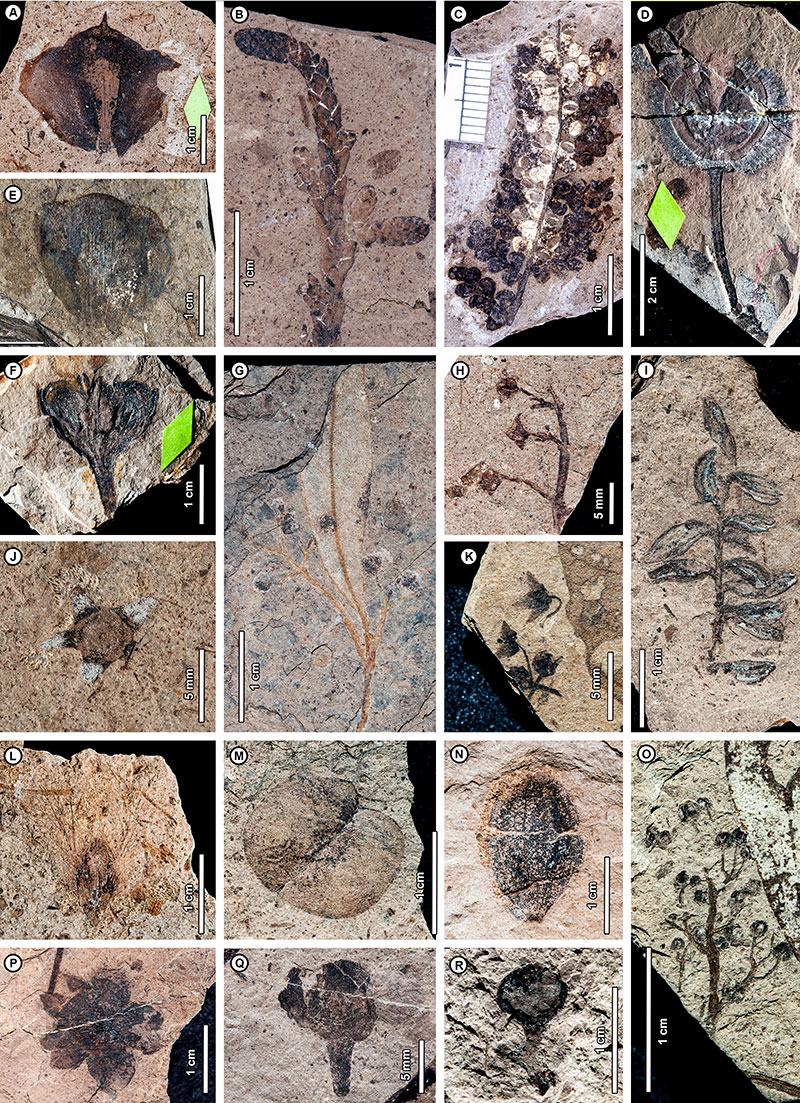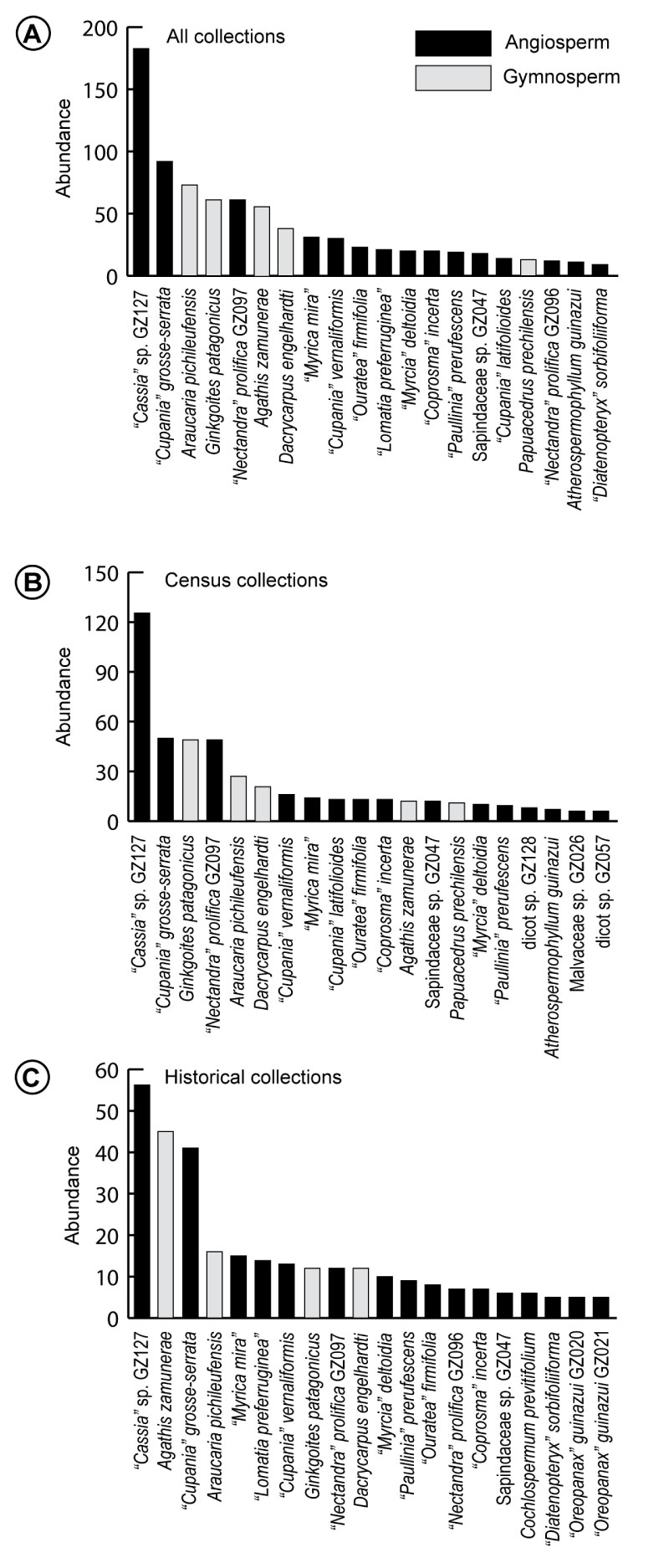FIGURE 1. Paleogeographic map showing the location of the middle Eocene Río Pichileufú site. Locations of the middle Eocene Río Pichileufú site in Río Negro Province, Argentina, as well as the early Eocene Laguna del Hunco site (Chubut Province) mentioned in the text, shown relative to nearby cities Bariloche, Argentina, and Trelew, Argentina. Map shows modern Argentina-Chile border and coastlines in black on a paleoreconstruction for the early Eocene (56 ma, C. R. Scotese, PALEOMAP Project).

FIGURE 2. The Río Pichileufú locality, then and now. Views are to the southeast. A, the valley with the fossiliferous exposures, as shown by Guiñazú (1940: fig. 29) and reproduced under Argentine public domain. Labels 1, 2, and 3, placed by Guiñazú, indicate his fossil sites. B, recent photos (by GRH) of the same area, showing exposed fossiliferous outcrops and quarries RP1-4. Historical location 1 roughly corresponds to our quarries RP1 and RP2, and location 2 corresponds to our RP3. Guiñazú did not collect at our RP4 quarry, although it is very close to our RP3, and we did not collect his location 3.

FIGURE 3. Exemplars of morphotypes GZ001‒GZ012, ferns (A‒D) and gymnosperms (E‒L). Names (see Appendix 1 for authorities) are provided for general reference, but in many cases, the same botanical name may apply to more than one morphotype, or one morphotype may encompass more than one name (Appendices 1, 5; see text for discussion). A, GZ001, “Dicksonia” patagonica, USNM PAL 40379a; B, GZ002, “Asplenium” incertum, USNM PAL 40380; C, GZ003, “Goniopteris” patagoniana, USNM PAL 40382; D, GZ004, (BAR) RP3_2005_610; E, GZ005, possible cycad, BAR 5600; F, GZ006, Ginkgoites patagonicus, BAR 4312; G, GZ007, Araucaria pichileufensis, BAR 5347; H, GZ008, Agathis zamunerae, USNM 40378d; I, GZ009, Papuacedrus prechilensis, (BAR) RP3_2005_1035; J, GZ010, Retrophyllum oxyphyllum, (BAR) RP3_2005_93A; K, GZ011, Dacrycarpus engelhardti, USNM 40385h; L, GZ012, Podocarpus andiniformis, USNM 40384.

FIGURE 4. Exemplars of morphotypes GZ013‒GZ023, monocots (A‒D) and toothed palmate or pinnately lobed leaves (E‒K). A, GZ013, BAR 4365; B, GZ0014, (BAR) RP3_2005_265; C, GZ015, BAR 1178; D, GZ016, possible Ripogonum, (BAR) RP3_2005_747; E, GZ017, “Cissus” pichileufensis, USNM PAL 40455 (reproductives are shown in Fig. 14K); F, GZ018, BAR 4361; G, GZ019, “Cochlospermum” previtifolium, USNM PAL 40468c; H, GZ020, “Oreopanax” guinazui, USNM PAL 40486a; I, GZ021, “Oreopanax” guinazui, USNM PAL 40486c; J, GZ022, “Triumfetta” irregulariter-serrata, USNM PAL 40465; K, GZ023, BAR 4516.

FIGURE 5. Exemplars of morphotypes GZ024‒GZ035, palmate entire-margined leaves. A, GZ024, “Sterculia” patagonica, USNM PAL 40461; B, GZ025, “Sterculia” guinazui, USNM PAL 222688a; C, GZ0026, (BAR) RP3_2005_810; D, GZ0027, “Strychnos” patagonica, USNM PAL 40507; E, GZ0028, (BAR) RP3_2005_978; F, GZ029, “Bignonia” pichileufana, USNM PAL 40495b; G, GZ030, BAR 4595; H, GZ031, BAR 4226; I, GZ032, “Polioexolobus” prenuntius, USNM PAL 40504d; J, GZ033, BAR 4494; K, GZ034, BAR 4486; L, GZ035, BAR 4717.

FIGURE 6. Exemplars of morphotypes GZ036‒GZ047, toothed leaves. A, GZ036, Lomatia preferruginea, USNM PAL 219145; B, GZ037, BAR 4272; C, GZ038, (BAR) RP3_2005_1105; D, GZ039, “Banara” cuadrae, USNM PAL 40450c; E, GZ40, BAR 4662; F, GZ041, “Celtis ameghinoi”, USNM PAL 40395a; G, GZ042, (BAR) RP3_2005_874; H, GZ043, “Eucryphia” tertiaria, USNM PAL 40456; I, GZ044, “Tabebuia” ipiformis, USNM PAL 40508b; J, GZ045, (BAR) RP3_2005_827; K, GZ046, “Cupania” grosse-serrata, BAR 4270; L, GZ047, Anacardites pichileufensis, (BAR) RP3_2005_812.

FIGURE 7. Exemplars of morphotypes GZ048‒GZ062, toothed leaves. A, GZ048, “Diatenopteryx” sorbifoliiformis, (BAR) RP3_2005_813; B, GZ049, (BAR) RP3_2005_537; C, GZ050, BAR 4627; D, GZ051, “Cupania” latifolioides, USNM PAL 219129; E, GZ052, “Cupania” vernaliformis, USNM PAL 40438g; F, GZ053, “Villaresia” congonhafolia, USNM PAL 40445; G, GZ054, (BAR) RP3_2005_1111; H, GZ055, (BAR) RP3_2005_1130; I, GZ056, “Fagara” serrata, USNM PAL 40418; J, GZ057, (BAR) RP3_2005_617; K, GZ058, BAR 4569; L, GZ059, (BAR) RP3_2005_583; M, GZ060, (BAR) RP3_2005_1052; N, Atherospermophyllum guinazui, USNM PAL 40403a; O, GZ062, USNM 40403e.

FIGURE 8. Exemplars of morphotypes GZ063‒GZ078, toothed leaves. A, GZ063, (BAR) RP3_2005_514; B, GZ064, “Paullinia” prerufescens, USNM PAL 40441b; C, GZ065, “Casearia” patagonica, USNM PAL 40454b; D, GZ066, “Casearia” patagonica, USNM PAL 40454a; E, GZ067, (BAR) RP3_2005_1089; F, GZ068, “Styrax” glandulifera, USNM PAL 40491; G, GZ069, “Psidium” aracaforme, USNM PAL 40489; H, GZ070, “Azara” celastriniforma, USNM PAL 40448a; I, GZ071, “Azara” celastriniforma, USNM PAL 40448B; J, GZ072, BAR 4542; K, GZ073, “Maytenus” latifolioides, USNM PAL 219096; L, GZ074, BAR 4649; M, GZ075, BAR 4611; N, GZ076, “Ouratea” firmifolia, USNM PAL 40459c; O, GZ077, BAR 4714; P, GZ078, “Banara prehernandiensis”, BAR 4622.

FIGURE 9. Exemplars of morphotypes GZ079‒GZ094, toothed leaves (A-E) and entire leaves (F-Q). A, GZ079, “Tetracera” sp., USNM PAL 40463; B, GZ080, “Myrica mira”, USNM PAL 219086; C, GZ081, “Myrica mira”, USNM PAL 219086; D, GZ082, BAR 4261; E, GZ083, BAR 4467; F, GZ084, “Coprosma” incerta, USNM PAL 40497a; G, GZ085, “Cephalanthus” glabratiflolius, USNM PAL 40496a; H, GZ086, BAR 4491; I, GZ087, (BAR) RP3_2005_656; J, GZ088, BAR 4266; K, GZ089, BAR 4673; L, GZ090, (BAR) RP3_2005_763; M, GZ091, “Plumeria” articulatifolia, USNM PAL 40503; N, GZ092, “Myrcia” deltoidea, BAR 4365; O, GZ093, (BAR) RP3_2005_593; P, GZ094, BAR 4728; Q, GZ095, “Tetrapteris” precrebrifolia, USNM PAL 40429b.

FIGURE 10. Exemplars of morphotypes GZ084‒GZ112, entire leaves. A, GZ096, “Nectandra” prolifica, USNM PAL 40429b; B, GZ097, “Nectandra” prolifica, USNM PAL 40471e; C, GZ098, “Nectandra” prolifica, USNM PAL 40471d; D, GZ099, “Nectandra” prolifica, USNM PAL 40471f; E, GZ100, BAR 4685; F, GZ101, (BAR) RP3_2005_501; G, GZ102, (BAR) RP3_2005_869; H, GZ103, BAR 4500; I, GZ104, “Dalbergia” patagonica; USNM 40416a; J, GZ105, BAR 4308; K, GZ106, (BAR) RP3_2005_905; L, GZ107, (BAR) RP3_2005_1019; M, GZ108, BAR 4677; N, GZ109, “Inga” patagonica, USNM PAL 40402; O, GZ110, (BAR) RP3_2005_506; P, GZ111, (BAR) RP3_2005_731; Q, GZ112, BAR 4310.

FIGURE 11. Exemplars of morphotypes GZ113‒GZ128, entire leaves. A, GZ113, “Remijia” tenuiflorifolia, USNM 40505a; B, GZ114, (BAR) RP3_2005_899; C, GZ115, BAR 4430; D, GZ116, “Tetrapteris” precrebrifolia, USNM PAL 40429a; E, GZ117, “Styloceras” tertiarium, USNM PAL 40428b; F, GZ118, (BAR) RP3_2005_743; G, GZ119, “Myrcia” obovata, USNM PAL 40483a; H, GZ120, (BAR) RP3_2005_688; I, GZ121, “Schinopsis” morongifolia, USNM PAL 40426; J, GZ122, “Erythroxylon” cuneifolioides, USNM PAL 219093b; K, GZ123, “Banisteria” patagonica, USNM PAL 40413e; L, GZ124, “Bumelia” australis, USNM PAL 40478; M, GZ125, “Drimys” patagonica, USNM PAL 40397a; N, GZ126, “Cedrela” pichileufuana, USNM PAL 40415a; O, GZ127, “Cassia” argentinensis, (BAR) RP3_2005_998; P, GZ128, (BAR) RP3_2005_876.

FIGURE 12. Exemplars of morphotypes GZ129‒GZ143, entire leaves. A, GZ129, “Styrax” acuminatiformis, USNM PAL 222672; B, GZ130, “Styrax” acuminatiformis, USNM PAL 222674; C, GZ131, (BAR) RP3_2005_954; D, GZ132, BAR 4514; E, GZ133, “Buettneria” asterotrichiformis, USNM PAL 40452; F, GZ134, “Echites” tertiaria, USNM PAL 40500b; G, GZ135, (BAR) RP3_2005_821; H, GZ136, “Omphalea” patagonica, USNM PAL 40424; I, GZ137, BAR 4596; J, GZ138, (BAR) RP3_2005_990; K, GZ139, (BAR) RP3_2005_622; L, GZ140, “Ficus” patagonica, USNM PAL 40400; M, GZ141, BAR 4710; N, GZ142, “Salacia” floribundifolia, USNM PAL 40443a; O, GZ143, “Leptolobium” prenitens, USNM PAL 40420.

FIGURE 13. Exemplars of morphotypes GZ144‒GZ158, entire leaves. A, GZ144, BAR 4492; B, GZ145, BAR 4524; C, GZ146, (BAR) RP3_2005_508; D, GZ147, “Cedrela” mexicaniformis, USNM PAL 40414a; E, GZ148, (BAR) RP3_2005_589; F, GZ149, “Goeppertia” ovatifolia, USNM PAL 40469a; G, GZ150, “Phoebe” elliptica, USNM PAL 40474; H, GZ151, (BAR) RP3_2005_935; I, GZ152, “Phoebe” lanceolata, USNM PAL 40475; J, GZ153, “Symplocos” commutatifolia, USNM PAL 40492; K, GZ154, “Banisteria” patagonica, USNM PAL 40413a; L, GZ155, BAR 4220; M, GZ156, (BAR) RP3_2005_513; N, GZ157, (BAR) RP3_2005_739; O, GZ158, “Polioexolobus” prenuntius, USNM PAL 40504b.

FIGURE 14. Diversity of reproductive structures at Río Pichileufú. A, Araucaria pichileufensis ovuliferous complex, USNM PAL 40383e; B, Araucaria pichileufensis pollen cones attached to leafy branches, BAR 289-20; C, fertile leaf of “Dicksonia” patagonica, USNM PAL 40379b; D, “Cochlospermum” previtifolium fruit, USNM PAL 40468d; E, Agathis zamunerae ovuliferous complex, BAR 4751; F, Malvacarpus guinazui, USNM PAL 40457a; G, BAR 4706; H, (BAR) RP3_2005_999; I, “Allophylus” eduliformis, BAR 4284; J, cf. Ceratopetelum sp. (BAR) RP3_2005_712; K, USNM PAL 40455a; L, (BAR) RP3_2005_928; M, (BAR) RP3_2005_1156; N, BAR 4355; O, USNM PAL 771250; P, BAR 4591; Q, BAR 4229; R, Carpolithus pichileufensis, USNM PAL 40509. Note that Raiguenrayun cura, an exquisite Asteraceae capitulum, is not illustrated here because it is from a different collection and was described previously (Barreda et al., 2010, 2012).

FIGURE 15. Top 20 most abundant foliage taxa at Río Pichileufú. A, all combined collections (as listed in Table 3); B, census collections (collections from 2002, 2005); C, historical (type and cohort) collections (the Guiñazú collection described by Berry, 1938).


